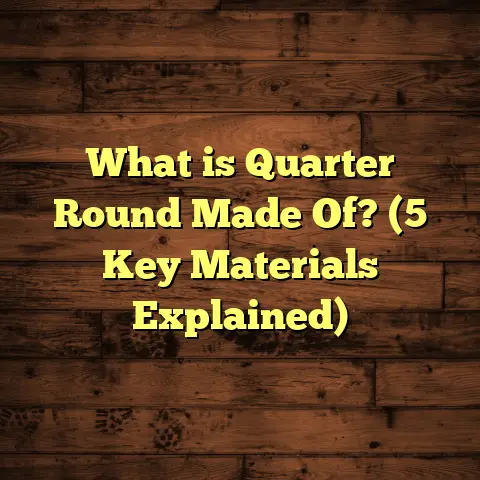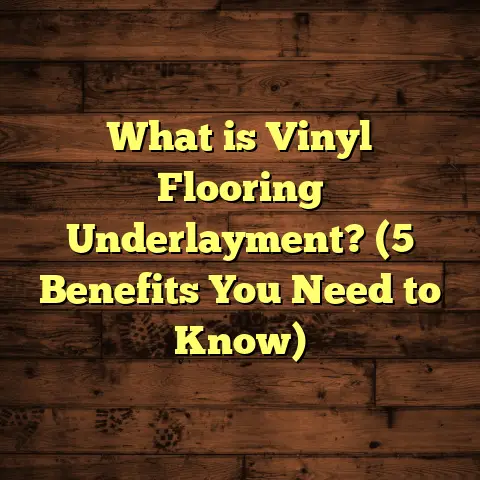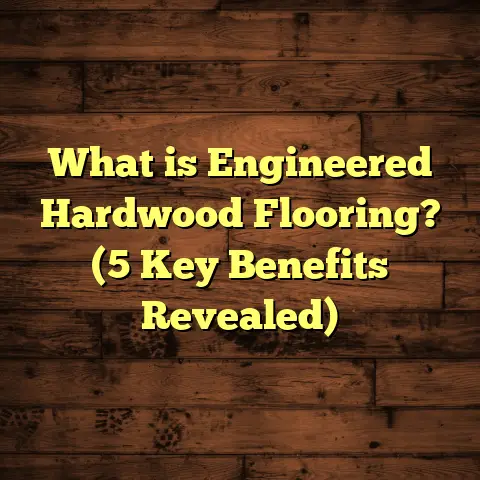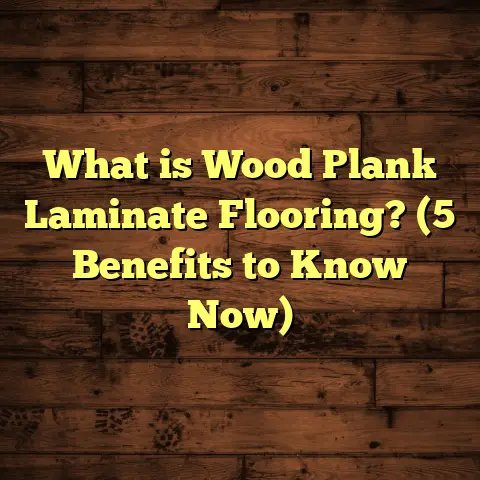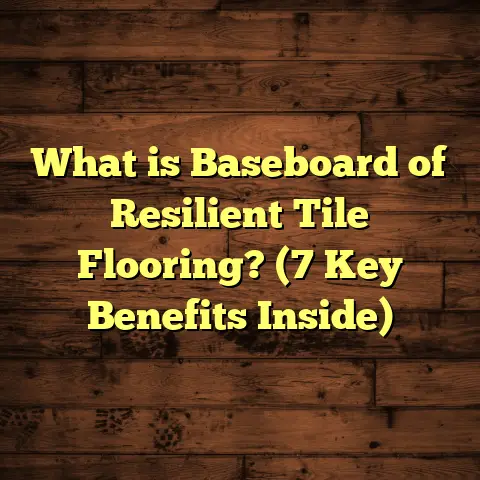What is Excessive Moisture in a Concrete Floor? (5 Key Signs Revealed)
Have you ever stepped into a room and felt a strange dampness beneath your feet? Maybe you noticed your freshly installed hardwood floor buckling or your vinyl flooring bubbling up in certain spots. These are frustrating signs that something’s wrong beneath the surface—specifically, with moisture trapped inside your concrete floor slab. I’ve seen this scenario more times than I can count in my years as a flooring contractor.
Excessive moisture in concrete floors is a silent issue that can destroy your flooring investment if left unchecked. But what exactly is excessive moisture? How can you spot it before it ruins your floors? What causes it, and what can you do about it?
I want to walk you through everything I’ve learned over decades in the field—sharing real numbers, personal stories, detailed explanations, and practical advice so you understand this problem deeply and know how to handle it.
What Is Excessive Moisture in a Concrete Floor?
Let’s start with the basics. Concrete is made by mixing cement, water, sand, and aggregate. When poured, concrete goes through a curing process that relies on water. This means, by nature, concrete contains moisture. The issue arises when this moisture doesn’t evaporate properly or when additional water seeps into the slab from outside sources.
Excessive moisture in a concrete floor means that the level of moisture within the slab surpasses safe limits for installing flooring materials on top. The moisture can exist as free water in pores or as water vapor moving upward through the slab.
This matters because many flooring materials—like hardwood, laminate, engineered wood, vinyl planks, and even some tiles—are sensitive to moisture. If the slab is too wet, these materials can warp, peel, bubble, crack, or develop mold underneath.
Measuring Moisture in Concrete
To understand whether moisture is excessive or not, professionals use standard tests:
- Calcium Chloride Test (ASTM F1869): This measures how many pounds of moisture vapor are emitted from 1,000 square feet of concrete over 24 hours. Flooring manufacturers usually recommend less than 3 pounds per 1,000 sq ft/24 hrs for wood or vinyl installations.
- Relative Humidity Test (ASTM F2170): This measures the percentage of humidity inside the slab by placing probes several inches deep into drilled holes. The threshold here is typically below 75% relative humidity.
- Moisture Meter Readings: Handheld meters measure surface moisture but are less reliable for slab moisture.
When levels exceed these limits, it’s considered excessive moisture.
Why Does Excessive Moisture Matter So Much?
Let me share a story from early in my career. I was contracted to install hardwood flooring over a basement slab in a home built in the 1960s in Minneapolis. The homeowner was eager to get the project done quickly. We didn’t test for moisture first, thinking the old concrete would be dry enough after decades.
Within two weeks after installation, the hardwood started buckling and lifting in large sections. The homeowner was devastated—this was an expensive floor. Upon investigation, I found high moisture vapor emission rates from the slab—over 5 pounds per 1,000 sq ft/24 hrs—far above recommended limits.
The root cause? No vapor barrier was installed under the slab originally, and seasonal groundwater was seeping up through micro cracks. Fixing this meant removing the hardwood floor, drying out the slab with specialized equipment for weeks, installing a vapor barrier on top of the slab, and then reinstalling new flooring.
The total cost? Nearly $20,000 including labor and materials—a painful lesson for the homeowner.
I’ve seen similar costly failures across different climates—Seattle basements with rainwater seepage, Florida homes with high groundwater tables, and desert areas where improper curing trapped too much water inside slabs.
5 Key Signs of Excessive Moisture in Concrete Floors
How do you know if your concrete floor has too much moisture? Here are five signs I rely on when inspecting floors:
1. Visible Water or Damp Spots
If you see standing water after heavy rains near foundation walls or damp patches on your basement floor that don’t dry quickly, it’s a red flag.
In Portland, Oregon, I worked on a home that had persistent damp spots on its basement floor every rainy season. We conducted calcium chloride tests which measured 4.8 pounds per 1,000 sq ft/24 hours—well above acceptable limits.
The fix involved improving exterior drainage systems and installing an epoxy moisture barrier coating on the slab surface before laying tile flooring.
2. Flooring Peeling, Bubbling or Warping
This one is often how homeowners first realize there’s a problem because damage appears on their new floors.
A Miami condo client called me after noticing their engineered hardwood floor bubbling up and peeling within three weeks of installation. Moisture testing revealed slab relative humidity at 85%.
We removed the flooring and applied a moisture mitigation membrane before reinstalling new planks designed for higher moisture environments.
3. Musty Odors or Mold Smells
Have you ever smelled that distinct musty odor in basements or rooms with concrete floors? That’s often mold growing due to trapped moisture under the floor covering.
In humid places like Louisiana and Florida, I frequently recommend combining moisture testing with mold inspections when clients report these odors.
4. Cracks or Efflorescence on Concrete Surfaces
Efflorescence looks like white powdery salt deposits on concrete surfaces caused by water carrying dissolved salts to the surface as it evaporates.
A Chicago client had efflorescence along basement walls and floors indicating moisture migration through the slab. Moisture vapor emission rates were over 4 pounds per 1,000 sq ft/24 hrs.
This required sealing wall cracks and applying both exterior drainage fixes and interior vapor barriers.
5. High Moisture Test Results
Ultimately, testing is the most reliable way to confirm excessive moisture.
If you’re planning flooring installation and haven’t tested yet, consider investing $100-$300 for professional calcium chloride or relative humidity testing.
I’ve seen readings range widely:
- Dry slabs: 1-2 lbs/1,000 sq ft/24 hrs or less than 60% RH
- Risk zone: 3-4 lbs/1,000 sq ft/24 hrs or 70-75% RH
- Excessive moisture: Over 4 lbs or above 75% RH
Exceeding these numbers means you need treatment before installing sensitive flooring.
What Causes Excessive Moisture in Concrete Floors?
Understanding what causes excessive moisture helps prevent future issues.
Lack of Vapor Barrier Under Slabs
Many older homes (built pre-1980s) skipped installing plastic sheeting under concrete slabs during construction.
Without this barrier, moisture from soil migrates upward into slabs freely. Vapor barriers installed under slabs reduce vapor transmission by up to 99%.
Poor Exterior Drainage
Water pooling around foundations due to clogged gutters or improper grading seeps into slabs over time.
I recommend homeowners maintain gutters and slope soil away from foundations by at least 6 inches over 10 feet distance to prevent water intrusion.
High Groundwater Tables
Homes near lakes, rivers, or coastal areas often have high groundwater levels that saturate soil beneath slabs.
In such cases, proper drainage and sump pumps may be necessary to keep slabs dry.
Plumbing or HVAC Leaks
Leaks under slabs introduce unexpected water loads. These can be hard to detect unless you see visible signs like wet spots or odors.
Improper Curing
Concrete needs proper curing time (usually at least 28 days) to allow water to evaporate slowly. Rushing installation of flooring materials too soon traps excess water inside slabs.
How I Approach Solving Excessive Moisture Problems
From my experience, addressing excessive moisture involves several key steps:
Step 1: Accurate Testing
I always start with both calcium chloride tests and relative humidity probes for an accurate picture. Surface moisture meters alone can’t detect deep slab moisture.
For example, on a commercial warehouse project in Texas spanning 15,000 sq ft concrete slab, we drilled multiple holes spaced evenly to place RH probes at 40% depth of slab thickness per ASTM F2170 recommendations.
Step 2: Identify Moisture Sources
I inspect exterior drainage conditions around foundations. Sometimes clearing gutters and regrading solves much of the problem.
For another project in New Jersey with persistent dampness under tile floors, we discovered a leaking underground pipe as primary cause—repairing this fixed the issue permanently.
Step 3: Select Mitigation Method
Depending on severity and budget:
- Epoxy Moisture Barriers: Applied as coatings over slabs to block vapor transmission; cost $1.50-$3.00 per sq ft.
- Sheet Membranes: Rolled plastic sheets adhered on top of slabs; cost $2-$4 per sq ft.
- Moisture-Tolerant Flooring: For moderate moisture cases, vinyl plank flooring or ceramic tiles may be better options.
- Drainage Improvements: Sometimes external drainage fixes are necessary before internal treatments.
Step 4: Retesting After Treatment
This step is crucial. After mitigation installation and drying time (usually around 2-7 days), I conduct follow-up tests to verify acceptable moisture levels before flooring installation proceeds.
Detailed Case Study: Basement Hardwood Flooring in Seattle
A client called me frustrated after their newly installed hardwood floor started cupping within two weeks. The home was built in 1995 with a basement slab but no known vapor barrier installed under concrete.
We ran both calcium chloride and RH tests:
| Test Type | Result | Recommended Limit |
|---|---|---|
| Calcium Chloride | 5.2 lbs/1000 sq ft/24 hrs | Under 3 lbs |
| Relative Humidity Probe | 84% RH | Under 75% |
Exterior inspection revealed clogged gutters causing water pooling near foundation walls every rainy season.
Solution:
- Clean gutters & install extensions
- Regrade soil away from foundation
- Apply epoxy moisture barrier coating on slab surface
- Install engineered hardwood designed for higher humidity environments
Outcome:
After treatment and retesting showed dropped RH to 70%, we installed new flooring without further issues. The client saved thousands by addressing root causes early instead of ripping out floors repeatedly.
How Much Does Moisture Testing & Mitigation Cost?
Pricing varies by region but here are typical ballpark figures:
| Service | Approximate Cost |
|---|---|
| Calcium Chloride Test Kit | $100 – $200 per test area |
| In-Situ RH Probes Rental/Purchase | $150 – $300 for rental |
| Professional Testing Service | $300 – $600 (multiple areas) |
| Epoxy Moisture Barrier Installation | $1.50 – $3.50 per sq ft |
| Sheet Membrane Installation | $2 – $4 per sq ft |
| Drainage Improvements | $500 – $5,000+ depending on scale |
Most homeowners spend between $500 and $4,000 total depending on size of area and severity of issues.
Tips for Homeowners Before Installing Flooring Over Concrete
- Always request or perform moisture testing before purchase or installation.
- If buying new construction homes built recently (post-2000), check builder warranty and ask about vapor barriers installed under slabs.
- Avoid rushing installation after pouring new concrete; standard cure time is at least 28 days.
- Consider using flooring materials with higher moisture tolerance if conditions warrant (e.g., luxury vinyl planks).
- Maintain exterior drainage systems regularly.
- If unsure about test results or mitigation options, consult experienced flooring contractors or building inspectors who specialize in moisture issues.
Common Myths About Moisture in Concrete Floors
Having been in this business long enough, I’ve heard some misconceptions that can lead homeowners astray:
Myth #1: “If the floor feels dry to touch, it’s safe.”
Surface dryness doesn’t mean slab moisture is low enough for flooring installation. Moisture can be trapped deep inside slab pores invisible to touch or sight.
Myth #2: “Old concrete slabs don’t hold moisture.”
Age doesn’t guarantee dryness—many old slabs were poured without vapor barriers and can still absorb groundwater over time.
Myth #3: “Plastic sheeting under concrete isn’t necessary.”
Building codes now require vapor retarders under slabs precisely because they help prevent moisture problems later on.
Final Thoughts From My Experience
Moisture issues in concrete floors are one of those hidden problems that can catch even seasoned homeowners off guard. But once you understand what excessive moisture means, how to spot signs early, and what steps to take for testing and mitigation—it becomes manageable.
The key is not to ignore warning signs like dampness underfoot or bubbling floors and invest in proper testing before installation. Trust me—the upfront cost pays off many times over by avoiding expensive repairs later.
If you’re planning a flooring project over concrete anytime soon—or already facing damage—reach out for expert testing or advice tailored to your climate and building conditions. There’s no one-size-fits-all solution because every slab is different depending on location, age, construction methods, and environment factors.
If you want help interpreting test results or deciding what type of flooring makes sense given your slab’s moisture levels—just ask! I’m happy to share more insights based on specific situations you describe.
Understanding excessive moisture isn’t just about protecting floors—it’s about protecting your home’s comfort and value for years to come.
Thanks for sticking through this detailed look at excessive moisture in concrete floors! If any part stood out or you have questions about your own project—I’m here when you need me.
